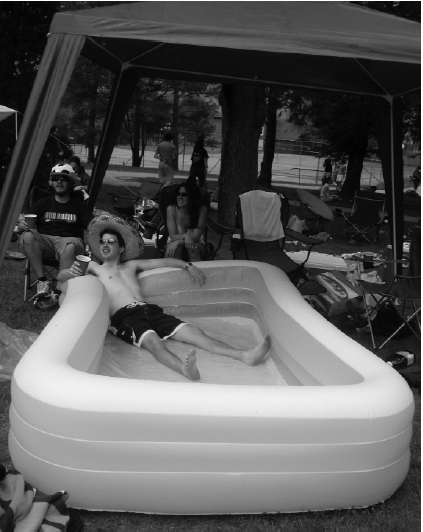My least favorite saying on this campus, more than “campus bubble” or “student apathy,” is the phrase “Engage in conversation.”
SGA has taken on a new Facebook initiative called “Fireside Chats,” with Nate Cornell offering us a post-game debrief of each weekly Assembly meeting. The web video series takes its name from FDR’s weekly radio broadcasts, when throughout the Great Depression the president sat before microphones to clarify the government’s role in a time of exasperation and anxiety. The chats were purposeful: On the Bank Crisis, On the Currency Situation, On the Works Relief Program. Cornell’s first video suggests that the campaign is to increase transparency in a similar vein, but I can’t imagine what student worries about the transparency of SGA – their minutes are always online, and they’ve been eager for a full visitors section since the class of 2011 were freshmen, if not longer. We can assume that the amiable Cornell sits before the PR VP’s FlipCam for a different reason: publicity. It’s a plea for student engagement with SGA’s goings-on, and to be fair, it’s a very smart one. Unfortunately, the videos suggest that SGA is losing their long-term memory.
Take, for example, “SGA Video Update #3”. In it, Cornell says, “SGA really discusses every year social responsibility, partying…and one thing that we had discussed as an SGA is sort of hosting a NESCAC summit, a teach-in, where we would invite all the student governments from all the NESCACS, and also some other senior administrators, the deans of Student Life as well, where we could really engage in conversations about alcohol and how we can work together to figure out the issues that we face on our campus. Colleges all across America are facing similar issues. This is something that has been well received within campus and within assembly.”
Let’s look at this a little more closely, based only on the information provided: the topic at hand here seems to be student drinking. Cornell says that this discussion happens every year, which leaves ambiguous whether or not they’re looking for a resolution. This year, they are looking to expand our ongoing, unresolved discussion to include the leaders of seven major colleges and universities. Additionally, they say they have brought it to “campus” – although exactly how and to whom is unclear – and that this campus has “responded positively.”
Unfortunately, a resolution cannot be reached, simply because The Issue has never been properly defined. What is our drinking problem? Is it a statistical fact, or a network of symptoms? Is it health related? Is it compromising our academics? Is it not prevalent enough? We’ve never been told. When Nate and his Fireside co-host Randy Lovelace suggest that we “figure out the issues that we face on our campus,” they are implicitly supporting the notion that this issue is someone else’s that we now have to fix. They’re placing the problem outside themselves. I’m not suggesting Nate and Lovelace have a problem. In fact, I’m suggesting quite the opposite: they, like I, like 81% of students on this campus, choose to drink alcohol, with most of us participating in our college’s drinking scene since freshman year.
When SGA suggests things like Summits and asks for delicate conversations about whether drinking underage is an issue of honor, it’s so incongruous with our lived experience that I wonder what happened to everyone I saw last weekend. Student Activities Council hosts and funds sweaty events with themes as conspicuous as Anything But Clothes. On Saturday nights the ’62 room is swept of beer bottles and lost high heels, and all that emerge are detagged Facebook photos and Peer Education flyers. I can’t imagine what our student leaders are trying to change about the drinking culture – I can’t imagine that they want it changed at all. Nonetheless, they continue to pay lip service to an institutional condescension that pathologizes its students without ever defining its disease in real terms. If anything is dangerous about drinking, it’s our schizophrenic way of talking about drinking when we’re sober: on the one hand, in the form of animated stories over Sunday Brunch, and on the other, in business-casual attire, using party lines like “facilitate communications” and “work toward conclusions.” It suggests shame. It lumps those with potentially clinical alcohol problems in with everyone who drinks socially. Most of all, it’s deeply hypocritical and a dishonor to ourselves.
If drinking on campus ever does diminish, it’s hard to imagine that “engaged conversation” and other non-objectives will be the cause. To really make a change, the Student Government Association should work to ease the rules to allow more areas for underage students to interact on drinking nights with upperclassmen, to let social influences happen organically as a mature outgrowth of seniors imparting aged experience on lower grades. For example, yes, hospital transports are expensive, invasive and embarrassing. Yes, you can mix that shot with two parts this juice, yes, in this glass, and surprise! You won’t have to make that pained face-scrunch every time you drink.
SGA is making the issue worse, not better, because they’ve failed to ask themselves a simple question: Why are we having the conversation about drinking? They’re communicating a vague sense of anxiety. We’ve been having conversations about drinking for years with each new Executive Board, and if the issue is not defined, the solution will never emerge.










This is one of the smartest things I’ve read in the voice in a very long time. thank you, lilah.
The “JBoard Hypocrisy” hypothesis is widely repeated, but I think SGA ought to be included as well. Excellent questions and well asked, LR-EIC.
[…] Rating -25: Junior Jennie Edgar Finds Herself in Mal … (33 votes) +22: On Defining the Issues (22 votes) +5: One Is the Loneliest Number: A freshman' … (11 votes) +7: DADT Opposition: A […]